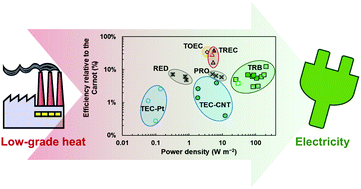当前位置:
X-MOL 学术
›
Energy Environ. Sci.
›
论文详情
Our official English website, www.x-mol.net, welcomes your feedback! (Note: you will need to create a separate account there.)
Emerging electrochemical and membrane-based systems to convert low-grade heat to electricity
Energy & Environmental Science ( IF 32.5 ) Pub Date : 2017-12-21 00:00:00 , DOI: 10.1039/c7ee03026f Mohammad Rahimi 1, 2, 3, 4 , Anthony P. Straub 4, 5, 6, 7 , Fang Zhang 8, 9, 10, 11 , Xiuping Zhu 4, 12, 13, 14 , Menachem Elimelech 4, 15, 16, 17 , Christopher A. Gorski 2, 3, 4, 12 , Bruce E. Logan 2, 3, 4, 12
Energy & Environmental Science ( IF 32.5 ) Pub Date : 2017-12-21 00:00:00 , DOI: 10.1039/c7ee03026f Mohammad Rahimi 1, 2, 3, 4 , Anthony P. Straub 4, 5, 6, 7 , Fang Zhang 8, 9, 10, 11 , Xiuping Zhu 4, 12, 13, 14 , Menachem Elimelech 4, 15, 16, 17 , Christopher A. Gorski 2, 3, 4, 12 , Bruce E. Logan 2, 3, 4, 12
Affiliation

|
Low-grade heat from geothermal sources and industrial plants is a significant source of sustainable power that has great potential to be converted to electricity. The two main approaches that have been extensively investigated for converting low-grade heat to electrical energy, organic Rankine cycles and solid-state thermoelectrics, have not produced high power densities or been cost-effective for such applications. Newer, alternative liquid-based technologies are being developed that can be categorized by how the heat is used. Thermoelectrochemical cells (TECs), thermo-osmotic energy conversion (TOEC) systems, and thermally regenerative electrochemical cycles (TRECs) all use low-grade heat directly in a device that generates electricity. Other systems use heat sources to prepare solutions that are used in separate devices to produce electrical power. For example, low-temperature distillation methods can be used to produce solutions with large salinity differences to generate power using membrane-based systems, such as pressure-retarded osmosis (PRO) or reverse electrodialysis (RED); or highly concentrated ammonia solutions can be prepared for use in thermally regenerative batteries (TRBs). Among all these technologies, TRECs, TOEC, and TRBs show the most promise for effectively converting low-grade heat into electrical power mainly due to their high power productions and energy conversion efficiencies.
中文翻译:

新兴的基于电化学和膜的系统将低级热量转化为电能
来自地热源和工厂的低级热量是可持续能源的重要来源,具有很大的潜力转化为电能。已经广泛研究了将低级热量转换为电能的两种主要方法,有机朗肯循环和固态热电,但并未产生高功率密度或在此类应用中具有成本效益。正在开发可替代的基于液体的新技术,可以根据热量的使用方式对其进行分类。热电化学电池(TEC),热渗透能量转换(TOEC)系统和热再生电化学循环(TREC)都直接在发电设备中使用低级热量。其他系统使用热源来准备溶液,该溶液用于单独的设备中以产生电能。例如,低温蒸馏方法可用于生产盐度差异较大的溶液,从而使用基于膜的系统(例如压力延迟渗透(PRO)或逆电渗析(RED))来发电。可以准备高浓度或高浓度氨溶液以用于热再生电池(TRB)。在所有这些技术中,TREC,TOEC和TRB显示出将低等级热量有效地转换为电能的最有希望的前景,这主要归功于它们的高发电量和能量转换效率。例如压力延迟渗透(PRO)或反向电渗析(RED);可以准备高浓度或高浓度氨溶液以用于热再生电池(TRB)。在所有这些技术中,TREC,TOEC和TRB显示出将低等级热量有效地转换为电能的最有希望的前景,这主要归功于它们的高发电量和能量转换效率。例如压力延迟渗透(PRO)或反向电渗析(RED);可以准备高浓度或高浓度氨溶液以用于热再生电池(TRB)。在所有这些技术中,TREC,TOEC和TRB显示出将低等级热量有效地转换为电能的最有希望的前景,这主要归功于它们的高发电量和能量转换效率。
更新日期:2017-12-21
中文翻译:

新兴的基于电化学和膜的系统将低级热量转化为电能
来自地热源和工厂的低级热量是可持续能源的重要来源,具有很大的潜力转化为电能。已经广泛研究了将低级热量转换为电能的两种主要方法,有机朗肯循环和固态热电,但并未产生高功率密度或在此类应用中具有成本效益。正在开发可替代的基于液体的新技术,可以根据热量的使用方式对其进行分类。热电化学电池(TEC),热渗透能量转换(TOEC)系统和热再生电化学循环(TREC)都直接在发电设备中使用低级热量。其他系统使用热源来准备溶液,该溶液用于单独的设备中以产生电能。例如,低温蒸馏方法可用于生产盐度差异较大的溶液,从而使用基于膜的系统(例如压力延迟渗透(PRO)或逆电渗析(RED))来发电。可以准备高浓度或高浓度氨溶液以用于热再生电池(TRB)。在所有这些技术中,TREC,TOEC和TRB显示出将低等级热量有效地转换为电能的最有希望的前景,这主要归功于它们的高发电量和能量转换效率。例如压力延迟渗透(PRO)或反向电渗析(RED);可以准备高浓度或高浓度氨溶液以用于热再生电池(TRB)。在所有这些技术中,TREC,TOEC和TRB显示出将低等级热量有效地转换为电能的最有希望的前景,这主要归功于它们的高发电量和能量转换效率。例如压力延迟渗透(PRO)或反向电渗析(RED);可以准备高浓度或高浓度氨溶液以用于热再生电池(TRB)。在所有这些技术中,TREC,TOEC和TRB显示出将低等级热量有效地转换为电能的最有希望的前景,这主要归功于它们的高发电量和能量转换效率。


























 京公网安备 11010802027423号
京公网安备 11010802027423号